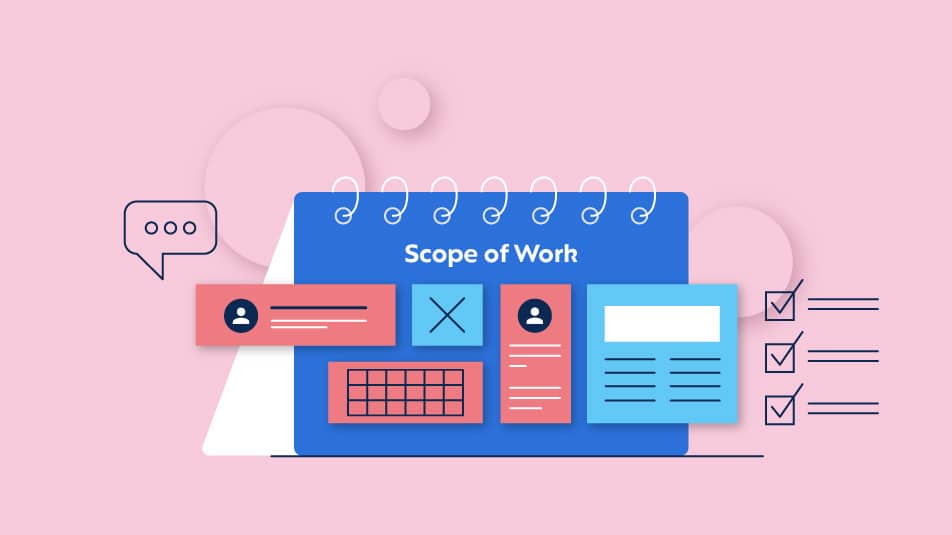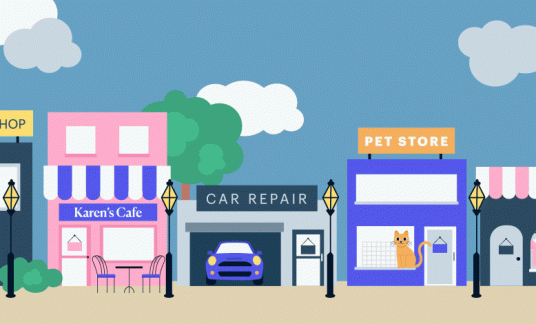A scope of work (SOW) for a website project is an essential part of ensuring the entire process runs smoothly and effectively for all teams involved.
We’ll run through what you can expect to see in a SOW and how you can use it successfully for your new website, whether you’re working with an internal marketing team or with an outside agency.
Scope of Work: Definition
Have you seen the term “scope of work” before, but aren’t completely sure what it means? A scope of work is a document that outlines the details of a project so all of the designers, strategists, developers, project managers and any outside vendors have all of the necessary information pertaining to the project all in one place.
Expectations must be aligned within a SOW document. If working with a marketing agency or freelancer, the scope must be approved before any part of the project begins. This will ensure the most efficient use of everybody’s time and limit any miscommunications. This is especially important when it comes to building a website.
Once you have everyone on the same page, and an agreement with the agency or freelancer has been signed, that’s when the real work can begin.
Next, you’ll learn more details about the 5 main sections that comprise a scope of work:
- Project Overview
- Creative Brief
- Task Assignment
- Agreement
- Payment Plan
1. Project Overview
The first component of a SOW defines the project clearly. Depending on how large the marketing team is, either one or a few members of the team will have meetings with you to understand what you’re looking for in your new, custom-made website.
The project manager will most likely ask a series of questions to write a SOW for their agency. For example, “What is the main objective for your new website?” and “Do you have current brand guidelines we should follow or would you like to establish a new style?”
Consider this scope of work example:
- Client: Yum Coffee
- Project number: YC004
- Date: January 24, 2021
- Project Description: Website design and development
- Background: A new brand of coffee opening shops throughout the U.S. this year
- Main Objectives: Spread brand awareness and sell coffee beans through the website
- Goals: Increase brand awareness by XX% and website traffic by XX% in 1 year from launch
- Team: Kim Schwartz (graphic designer), Lyle Bell (digital designer), Bobbie Wong (UX-UI strategist), Lowell Harvey (project manager), Leigh Simpson (copywriter), Winifred Swanson (art director), Jan Clayton (account manager) and Code Masters (web-development partner company)
2. The Creative Brief
In addition to the general project information, a scope of work contains a creative brief so the design team can effectively communicate the new website to the right people.
The 5 key categories that make up a creative brief are a large portion of the SOW document and are vital to the success of your website.
Deliverables
What will the end result look like? The SOW should answer that question. That means knowing the exact pieces expected to be delivered. Does this involve Photoshop files, a Sketch graphic or something else? Are layouts for desktop, tablet and mobile platforms required?
It also is crucial to know whether there will be continuous work based on the style of this project or if it is a one-off kind of deal. Perhaps there will be some banner ads or an email campaign driving traffic to the new site. As they say, the devil is in the details.
Strategy
What is the purpose of the project? What will drive people to the website? A good SOW answers these questions and defines the target demographic clearly.
A short list of top competitors is often included in a creative brief. It’s a good idea to understand how your competitors became successful and perhaps model similar functionality into your own website.
Tone
A SOW establishes the desired tone for the project. Should the site feel playful, serious, professional or even kid-friendly? This ensures work produced speaks directly to your target customer through both the language and the design elements.
Assets
Will the website project be built from the ground up? Or does it already have some foundation? If it’s the latter, there probably are some existing assets such as photography, icons, a color palette, copy or website structure that you need to move into the new website. This information is itemized in the SOW document.
Timeline
A SOW commonly establishes a specific timeline for each website milestone. At a minimum, it should include a broad timeline with the due date for site launch as well as developmental deadlines for the completion of key milestones.
Having a visual graph or chart helps everyone understand the span of the project more easily.

3. Task Assignment
A good SOW defines the details from individual to-do items to post-launch plans.
General To-Do List
A general to-do list defines exactly what needs to be done for the entire project as well as tasks for individual team members or departments. An overall to-do list will vary depending on the outcome of the initial meetings with the client.
For example, a large website redesign to-do list might look like this:
- Research
- Market analysis
- Competitor review
- Target demographics
- Find visual examples
- Strategy
- UX and UI strategies
- SEO strategy
- Information architecture (more details below)
- Wireframes
- Design
- Provide 3-5 new style directions with home page
- Work with strategy team on wireframes
- Based on the chosen style, create layouts for 10 pages in Photoshop
- Write out style instructions for developers
- Content creation
- Evaluate current website content
- Determine new tone
- Work with user-experience team on the information architecture
- Rewrite entire website copy
- Programming
- Developers to create an initial structure based on wireframes
- Code 10 pages based on Photoshop designs and check-in
- Code the remaining pages
- Communicate for testing and debugging
- Client meetings
- Present 3-5 new style directions
- Share 10 pages
- Share test link from developers
- Pre-launch training
- Post-launch evaluation
- Setup and testing
- Prepare new URL with a new host
- Beta-test internally
- Track changes with a debugging checklist for developers
- Beta-test with 40-50 randomly selected users
- Make final changes
- Launch
- Domain name system record transfer
- Launch party
Information Architecture
There is a lot more work that goes into a successful website redesign than most people think, defining a site’s information architecture is one of them. The site architecture should be agreed upon before both parties sign a SOW to begin the work.
This step is vital to the functionality and user experience (UX) of your website. Setting up the information architecture properly includes defining how the site structure and navigation will work (a.k.a., determine the number of main and subpages you’ll want). This is usually created by taking into account the market research and drawing out wireframes with a team of UX designers and strategists so that it’s easier for everyone to visualize the website structure.
Next, determine exactly what type of content should live on each page, and where you want people to click to get them to behave in a way that will achieve the goals you have defined in the first section of your SOW.
4. Agreement
Before a project officially begins, the agency (or freelancers and contractors) will need to have an agreement with legal terms and conditions signed. This will protect all parties in the event that either side needs to cancel the project. It also will outline how the resulting work can be shared publicly (or not) moving forward.
Having these signatures is necessary to start a successful project together. Agreement by everyone on a specific timeline and the tasks to be accomplished within that time will eliminate any confusion after the website project is underway. A successful agreement will build trust between the client and designers so that everyone cooperates and does their part.
5. A Payment Plan
As far as a project payment goes, there are a few different ways you might be billed: a monthly retainer, project-based or an hourly rate. These 3 options depend on the type of client, the size of the website project and how the agency or freelancers prefer to work.
Monthly Retainer
If the website needs a large overhaul as well as ongoing maintenance, the team hired to work on it might estimate a general timeline, but present a monthly retainer option. This is a chance to negotiate for a specific amount of work to be accomplished each month for a set price. Having an agency on-retainer can be especially helpful if the company plans to hire for continuous marketing and advertising efforts.
Project-Based
Plenty of experienced agencies and contractors have a very good idea of the amount of time it should take them to accomplish a full website redesign. If that’s the case, discuss a payment plan based on the project milestones.
Hourly Rate
Perhaps your website just needs a touch-up, or it isn’t clear how much time a full redesign for the business will take. Many freelance designers charge by the hour. Some agencies will track their individual employee’s time and then bill you accordingly at the end of each month. If that’s the case, they will present a projected estimate, but that estimate will be subject to change based on the amount of work that is actually done during the month.
Good SOW Equals Good End Result
Having everyone on the same page with understanding their individual moving parts inside of the larger project is a must when working on a website. A detailed SOW document sets up a project for success.
The overall goal of a SOW should be to set clear expectations, ensure smooth productivity and protect the budget by keeping the project in scope.












